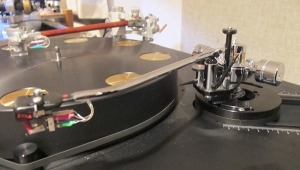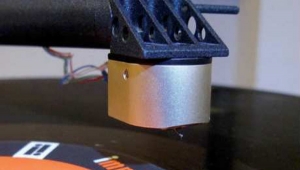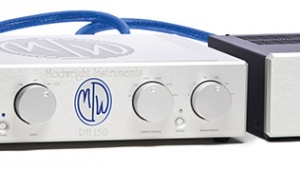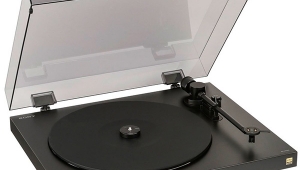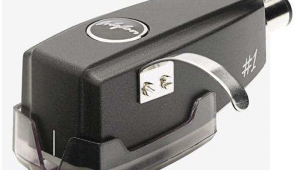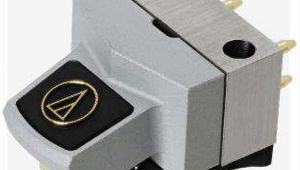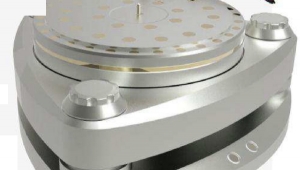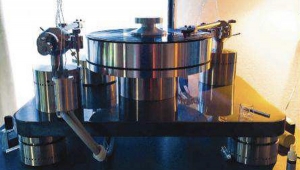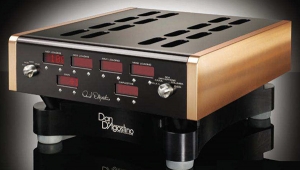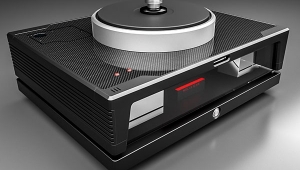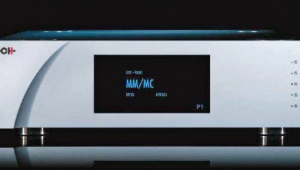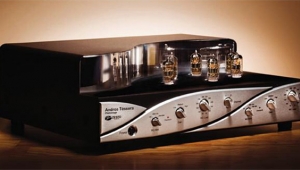| Columns Retired Columns & Blogs |
Analog Corner #249: LKV Research Veros One phono preamp, Triangle Art Apollo MC cartridge
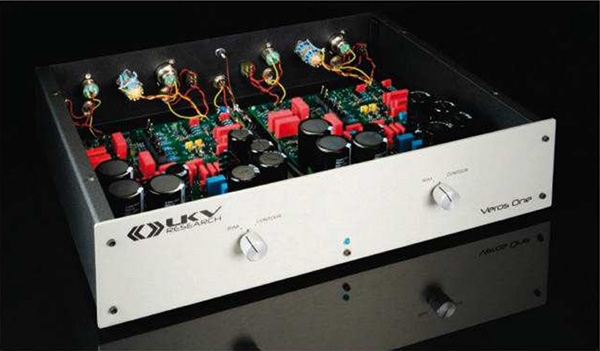
Designer Bill Hutchins, of LKV Research, builds the 2-SB moving-magnet/moving-coil phono preamplifier in North Conway, in the White Mountains of New Hampshire; he uses as many US-sourced parts as possible, and sells his products factory direct. I reviewed the 2-SB in March 2014, on AnalogPlanet.com: the 2-SB's sound was exceptionally fine—especially if you like refined, solid-state quiet and detail, and especially considering its then-price of $2500. Since that review's publication, the 2-SB has been upgraded with a version of the third gain stage from LKV's JFET-based Veros One phono preamp ($6500; see below), and its price has risen to a still-reasonable $3000.
Footnote 1: LKV Research, 19 Randall Farm, North Conway, NH 03860. Tel: (603) 730-7400. Web: www.lkvresearch.com
The LKV 2-SB works in class-A, has a fully differential balanced signal path with cascaded JFETs, bipolar transistors, and zero looped feedback, and a robust outboard power supply. Its high-quality components include low-dielectric-absorption, polypropylene capacitors in the signal path; dual-mono, four-layer circuit boards; and three switchable grounding options that should eliminate even the most daunting ground-loop hums.
The 2-SB's overall design is kit-like—it wouldn't be unfair to describe it as rudimentary—with the two circuit boards, one per channel, secured to the chassis floor, and everything connected to the input facilities with pairs of twisted wires, Dynakit style. The aluminum case, powder-coated in black, is internally damped top and bottom with a mass-loaded polymer sheet, and held together with sheet-metal screws. (A similar box houses its external power supply.) This, too, is basic, but considering the technology within, and especially the sound, these were smart choices to keep the price down. On the rear panel are single-ended (RCA) and balanced (XLR) inputs and outputs. Each 2-SB is tested and listened to before being sent to its buyer, who is given a printout of his unit's measured performance—unusual, at this and most price points.
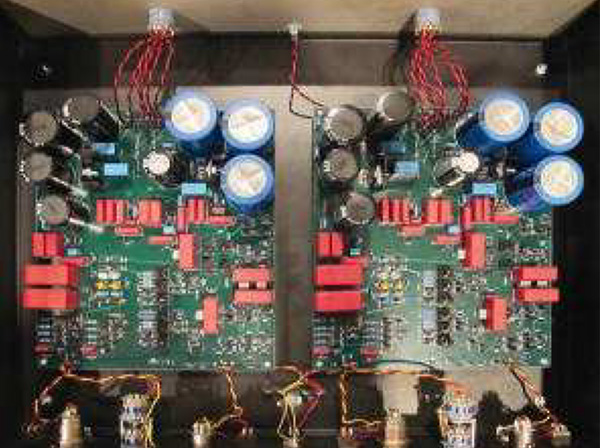
LKV Research Veros One MM/MC phono preamplifier
In May 2014, Bill Hutchins introduced the Veros One phono preamplifier ($6500; footnote 1)), and later that month demonstrated it at that year's T.H.E Show Newport Beach. The Veros One contains even more premium parts than does the 2-SB, and features what LKV Research describes as "innovative RIAA circuitry" and "extremely quiet gain blocks" to reach new levels of performance in terms of low noise floor and dynamic headroom. The filtering and regulation of the power supply have also been upgraded.
The Veros One's physical construction and quality are similar to those of the 2-SB. Attached to the chassis bottom are two circuit boards, connected with pairs of twisted wires to the rear-panel inputs and outputs and adjustment facilities; as with the 2-SB, the user has a choice between single-ended and balanced outputs and between single-ended and balanced inputs. The Veros One's thin, brushed-aluminum faceplate is attached to the chassis with four black machine screws.
One of Hutchins's goals was to make the Veros One easier to use than the 2-SB, whose top panel you have to remove to adjust loading via a series of small jumpers. The Veros One's rear panel offers 10 loading options via a dual-mono pair of multipole switches to which resistors are directly soldered. The choices are 25, 37.5, 50, 100, 200, 350, and 500 ohms, and 1k, 23.7k, and 47.5k ohms, all values referring to use with single-ended inputs. (The balanced-input values for each setting are also marked on the rear panel.) That adjustment range should be sufficient for all but those obsessed with loading values.
Unlike many phono preamps, the Veros One offers three gain settings, the specs for which differ with respect to the preamp's output mode: with the Veros One set for single-ended output, the choices are 57, 52, and 34dB, while the choices are 62, 58, and 40dB when the preamp is used in balanced-output mode. In addition, there's an optional 6dB boost that produces, for instance, up to 64dB gain in single-ended output, for very-low-output MC cartridges. The goal in offering this flexibility is more than just providing enough gain for a given cartridge: according to LKV, it's to avoid the distortion and noise that arise when excessive phono-preamp gain forces the need for the system's line preamplifier to first attenuate and then re-amplify the signal. (LKV suggests that the best performance arises when the volume knob on the user's line preamp is set to no lower than 1 o'clock and the phono preamp is used at the lowest gain setting that produces the desired loudness.)
That may seem like a lot of work, but Hutchins is all about minimizing noise. The Veros One's specified signal/noise ratio, referenced to the 0.5mV input, is an impressive 70dB unweighted, and 75dB A-weighted, which takes into account the lower sensitivity of human hearing above and below 1000Hz. Those are impressive numbers by any measure—the Veros One's unweighted S/N ratio improves on that of the 2-SB by 11dB—and they equal or better those of some far more expensive phono preamps.
Still, Hutchins admits that there are other important parameters of design and performance—including RIAA accuracy, in the Veros One's case specified as ±0.1dB. The two small knobs on the faceplate—other than a power-on LED, there's nothing else—are dual-mono controls for choosing between RIAA and what Hutchins calls Contour; the latter, he says, produces "warmer, tube-like" sound by boosting the low and midbass frequencies by 2dB. The effect of this additive equalization was commendably subtle, and took the edge off particularly bright recordings. In my opinion, such an arrangement is far superior to offering multiple pre-RIAA curves, which too many audiophiles abuse and too many audio writers encourage them to use, erroneously claiming that major record labels continued to use their proprietary curves well into the stereo era. They did not.
In terms of construction and cosmetics, the LKV Veros One is only slightly less basic than the SB-2, at more than twice the price. This was somewhat disappointing, but I get it: Bill Hutchins is more a designer of circuits than of fancy cases, and his main goal is to provide maximal sound quality at minimal cost. For another design approach at a similar price, consider Luminous Audio Technology's Arion phono preamp ($6395; footnote 2). Ideally, I'd stage a shoot-out between these models, but for now that's not possible. The Arion is a single-box design housed in a far more substantial milled-aluminum case. It offers more convenience, with a single input that can be switched, with the press of a button on its front panel, between MM and MC—subminiature, small-signal, gold alloy-over-silver latching relays do the work—and it has a Mute button.
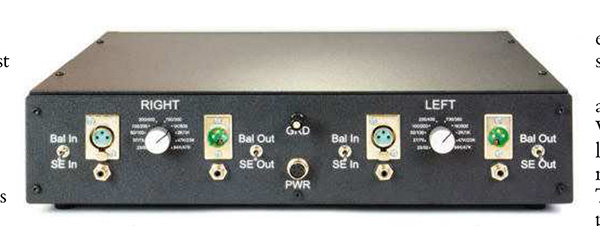
The Luminous Arion has single-ended RCA inputs, and a pair of "convenience" Neutrik XLR inputs wired in parallel with the single-ended input: Designer Mike Bettinger, who's designed circuits for 35 years, claims that because phono cartridges really aren't "balanced" (I agree), a balanced input requires producing a "pseudo ground" for the cartridge output and sending it through duplicate, carefully matched gain and equalization circuits to create a balanced output. (For Bill Hutchins's thoughts on this, read my review of the LKV 2-SB on AnalogPlanet.com).
Bettinger's position is that the better approach is to successfully reference the signal to the reference ground. If done correctly, that produces ultralow noise. The second stage is differential, optimized for the second stage's higher signal levels. Luminous specifies signal/noise ratios of 74dB (A-weighted) and 78dB (unweighted) for the Arion's MC input, and a gain of 62dB. In addition, Luminous claims that its one-box design can, through their use of proper power-supply shielding, produce noise levels as low as models powered by outboard supplies.
The Arion's gain is set at the factory at 42dB (MM) and 67dB (MC), though an "experienced technician" can change a feedback resistor to set the gain at 47, 52, 57, or 62dB. Resistive loading is via sockets that allow resistor values to be easily changed, but this requires removing the top plate's 10 hex-head screws—not nearly as convenient as the Veros One's rear-panel switches.
I'd love to get Hutchins and Bettinger together on a discussion panel and hear them explain their design philosophies and why each made the choices he made. Both are obviously very talented designers, and I think an audience made up of consumer-audio-show attendees would enjoy the exchange. How 'bout it, guys?
Back to the Veros One, described on its webpage as "a phono stage that removes the remaining veils between the listener and the music encoded in the grooves of the LPs. The soundstage is deep and the images within it, precise and solid. The music arises out of a still, black background revealing all the low level information that is critical to the meaning and emotional impact of the music. Dynamics are startling. The sound is detailed but natural and harmonically true."
Footnote 1: LKV Research, 19 Randall Farm, North Conway, NH 03860. Tel: (603) 730-7400. Web: www.lkvresearch.com
Footnote 2: Luminous Audio Technology, 1312 N. Parham Road, Richmond, VA 23229. Tel./Fax: (804) 741-5826. Web: www.luminousaudio.com
- Log in or register to post comments

